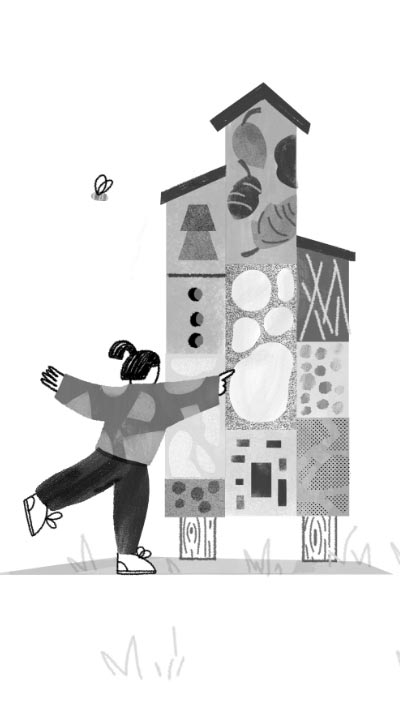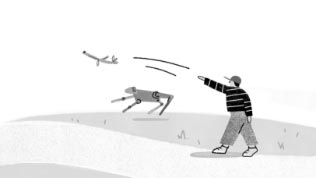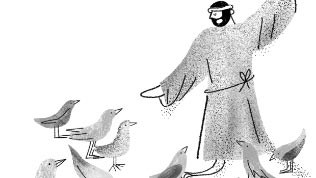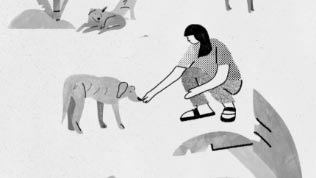Woman, mother, philosopher
by Ellie Robson
One female philosopher changed prevailing - and distinctly male - ideas of human relationships with animals.
Picture a familiar scene: a comfy living room, a group of friends, a David Attenborough documentary on TV. In the documentary, a mother cuckoo lays her egg, then gently places her unborn chick in the nest of another 'surrogate' bird species. Somehow, she dupes the new parents into taking the responsibility of raising her young before setting off to find a fresh mate. The viewers feel awe at the remarkable lives depicted.
Why is it that we feel this sense of awe? Why are we so astonished by the cunning and sophisticated behaviour displayed by the cuckoo? One answer was offered by the moral philosopher Mary Midgley. She argued that we have forgotten a deceptively simple truth: 'We are not just rather like animals; we are animals'.
In modern times, the truth that 'we are animals' has been obscured by our view of (wo)man as a purely rational being, whose definitive aspects - intelligence, reason, consciousness - are disembodied and isolated from the natural world. This connects with an embarrassment about our own animality. We are ashamed to be associated with anything 'beastly' or 'sub-human', mortified when described as 'eating like a pig' or 'being a leech'.
But in denying our own animal nature we obscure our essential continuities, similarities and connections with the non-human realm. We deny our dependence on the vast, self-regulating organism that maintains the conditions conducive to our lives - the natural earth, or, as James Lovelock calls it, 'the Gaia'.
Our awe is a consequence of the fact that we do not expect animals to behave in ways so like our own. The philosophy of Midgley asks us to re-imagine ourselves as animals. This is not to sensationally claim that humans are 'nothing but animals', as Desmond Morris did in 1967's The naked ape. It is to sensibly reveal that we are not wholly different from them and are, in fact, much more similar than we have come to appreciate.
A little more about Midgley. First and foremost, she was wise, publishing her first book at the age of 59; her philosophy is witty, whole-hearted and jargon-free. She was interested in communicating with a wide public readership and willing to talk and listen to anyone sharing her concerns. As a result, her expansive works span and connect many important topics, such as environmental ethics, education, feminism, science, art and politics.
Unlike your typical philosopher, Midgley was concerned with the nitty-gritty of life. In 20th-century philosophy, predominantly male thinkers sometimes practised what is known as 'armchair philosophy'. With their feet off the floor, armchair philosophers typically studied abstract concepts (all within easy reach of said armchair) such as logic, reason and the mind. A mother of three, Midgley never had time for comfy seats. She was much more concerned with the goings-on around the house. Domestic life impacted her thought. When reflecting on our development as moral beings, she drew on her experiences of the 'animal behaviour going on all around me, upstairs, in the garden and on the hearthrug'.
Sometimes, of course, a house needs a plumber. Midgley modestly portrayed herself as a 'philosophical plumber', locating and fixing blockages in our thinking. Like a plumber, she maintained the structures of ideas and beliefs under the floorboards of life, rechannelling the flow between areas that have become disconnected over time. These structures often come in the form of stories, symbols or - Midgley's favourite - myths by which we live our lives. Contrary to the common conception of myths as false or silly beliefs, Midgley saw them as complex networks of social, historical, scientific and natural symbols, offering particular ways of interpreting the world.
The origins of our muddled thinking
Over time, Midgley observed that myths can become 'draped with unsuitable symbolic values'. A bad myth blocks our thinking and reduces things whose complexity should be respected. Such myths sometimes arise from our temptation to simplify our concepts into binaries or dualisms (emotion-reason, mind-body, nature-nurture). Dualisms can be innocent but, like chemicals, are prone to become dangerous if combined imprudently. The reason-emotion binary, combined with the male-female binary, historically perpetuated sexist notions of women as 'hysterical' and 'irrational', unable to work and undeserving of a vote.
Such barriers contribute to a distorted vision of ourselves in relation to other animals. Midgley first set this forth in her 1978 book Beast and man, identifying a trend that goes back to monotheistic religions, which envisioned man as the only creature made in 'God's image', with dominion over all other animals in the 'chain of being'. In philosophical thought, René Descartes took this religiously sanctioned notion of the soul and identified it with reason. Fairly or not, 'Cartesianism' became the idea that what is essential to humans is our isolated rational minds, not our fleshy bodies or earthly appetites. Animals were condemned as irrational, soulless, unconscious objects or 'machines' incapable of subjectivity and apt for human use.
While moral philosophers sank into their armchairs, animals found themselves locked out of the house. The Enlightenment hailed reason as otherworldly and divine, a capacity which, if possessed, affords dignity and moral worth to its possessor. Creatures without reason were deemed 'beasts', excluded from circles of moral worth. A culture of human exceptionalism took root, setting mankind apart from the rest of nature.
Out of sight and out of mind, the lives of other animals took on fictional forms, often monstrous, highly moralised, or sentimentalised. Emptied of their own subjectivities, says Midgley, we came to see them 'not as they are, but as projections of our own fears and desires'. Animal desires are chaotic and impulsive. Wolves are cruel. Foxes are cunning. Pigs are greedy. Sharks are dangerous, indiscriminate killers. Comparison with these animals became repulsive and embarrassing. In this self-serving picture, animals are used as repositories for our worst traits and vices. All this made Midgley's claim that 'we are animals' an unpopular one.
An ideological hangover continues to block attempts to bring animals into our moral thinking today. Worse, new distortions have emerged. In testing labs, animals are pictured as 'standardised biological research tools'. In animal agriculture, animals are trivial objects, 'meat on legs', 'egg units'. Even with widespread scientific acceptance of human evolution, the deeply symbolic element of our thinking retains a dualism between beast and man today.
A new myth: admitting our continuity with nature
So, how can we fix this muddled thinking? Luckily for us, Midgley was herself a mythmaker. We can use her philosophy to unblock myths and bring animals back into clearer moral focus.
In the 1980s, Midgley was a key player in the first of the large-scale attempts to rethink the proper place of animals in our moral thinking. She was a philosopher and activist, for ten years a member (and at one time the chair) of the RSPCA's committee on animal experimentation. Oddly, her work is poorly represented in academic animal ethics. Midgley set herself apart from popular animal liberationists, such as Peter Singer, who tried to establish moral equality between the species by abolishing difference. For him, the only relevant capacity for moral consideration was sentience, the ability to feel pain and pleasure. For Midgley, by contrast, 'equality is not sameness' and sentience not the only consideration.
Attenborough, a fellow naturalist, is a perfect example of Midgleyan thinking in action. He does not deny the difference between (wo)man and other animals. But, by reminding us of the fantastic complexity in other animal life, he helps us to remember that this gap is narrower and messier than we have been taught. As Midgley puts it, we cannot treat all creatures as 'standard, unvarying, dough-like products'. There are important differences between species - so-called 'species barriers' - but these are only revealed to us when we attend to the lives of each species. In her book Animals and why they matter (1983), Midgley helpfully analogises the 'barrier' between species:
'the species-barrier, imposing though it may look, is rather like one of those tall wire fences whose impressiveness is confined to their upper reaches. To an adult in formal dress, engaged in his official statesmanly interactions, the fence is an insuperable barrier. Down below, where it is full of holes, it presents no obstacle at all. The young of Homo sapiens, like those of the other species present, scurry through it all the time. Since all human beings start life as children, this has the quite important consequence that hardly any of us, at heart, sees the social world as an exclusively human one'.
This passage brings us full circle, right back to the Midgleyan premise I started with, that we are animals. It also offers another important concept: the 'mixed community'. We share our communities with all manner of animals: cats, dogs, bugs, unwanted visitors, unknown housemates, sheep, pigeons, rodents and much else. Moreover, we are social mammals who, from a young age, live in a multispecies community. As rational animals, we are especially capable of living in harmony with other creatures, able to bring them into our rituals and understand their wants and feelings.
Let us return briefly to the armchair philosophers and their wilful detachment. For them, from their armchairs, the mixed, multispecies character of our world is out of reach. This community is only visible when we stretch our legs to walk the dog, watch the birds, turn over an old log, or stare into the night sky. Children are good at revealing this community to us. Scurrying once again through Midgley's wire fence, they poke and prod, coming into all sorts of contact with animals.
Is it significant that it took a woman philosopher, defying the armchair tradition, to remind us of our animal natures? In a radio script that never went to broadcast, entitled Rings and books, Midgley observes that, in the canon of our 'greatest philosophers', most have been male bachelors. With few exceptions, such as John Stuart Mill and Aristotle, our most influential thinkers never experienced life with a dependent other - a woman, man or child, an elderly relative or pet (Descartes' beloved dog remains the irony of this entire tale). As Midgley puts it, a pattern of withdrawal from the real world contributes towards 'a certain over-abstractness, a certain remoteness from life, in the European philosophical tradition'.
It took Midgley - a person experienced in caring for children (and let's not forget Attenborough, caring for the animals) - to elucidate this argument. 'Small children', for Midgley, 'are so literally and unmistakably both animals and human beings that they show up the absurdity of refusing to bring these two notions together'. Engaging with children and animals is a route to remembering the reality of our own animal condition.
Our new Midgleyan myth pictures humans as firmly embodied and dependent not only on one another, but also on the natural world. As Midgley writes in her book Evolution as a religion (1985):
'Of course, human beings are distinct individuals. But they are also tiny, integral parts of this planet - framed by it' and adapted to a certain place among its creatures. Each receives life in a family (as a petal does in a flower), in a country (as the flower does on the tree), and in the biosphere (as the tree does in the forest). Our environment gives us nearly everything we have'.
Our family, our fellow creatures and our biosphere are all at risk if our muddled thinking continues. As I write, the landmark Environment Bill is passing through the UK's House of Lords. Our diverse planet, the Gaia, was likened by Baroness Bennett to the 'library of life'. Our actions as a species are busy burning that library down.
If we are to save the library, serious philosophical work is needed. This means leaving our comfy armchairs, pulling on our gloves and attending to what is beneath - the concepts, stories and myths we live by. We must start writing a new myth: a stirring story of humans as remarkable animals among many others, responsive to the needs of the Gaia on which we depend. Perhaps reading Mary Midgley is a good place to start.

Ellie Robson
Ellie Robson is a CHASE DTP-funded PhD researcher at Birkbeck, University of London. Focusing primarily on the philosophy of Mary Midgley, Ellie works mainly on 20th-century women in philosophy, exploring themes of naturalism and human nature. Ellie discovered the philosophy of Midgley through the In Parenthesis project at Durham University, where she completed both her BA(hons) and masters degrees in philosophy.



